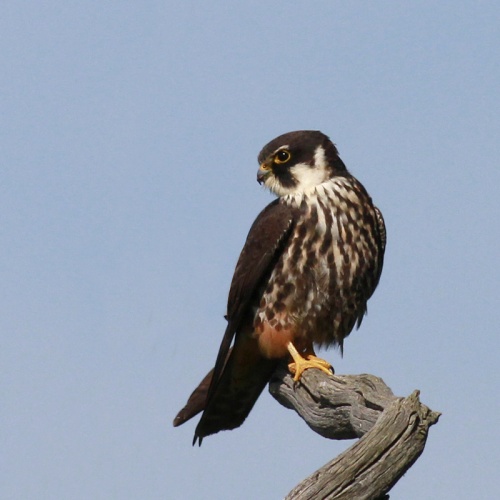- Falco subbuteo
Identification
28–36 cm (11-14¼ in)
Adults are slate-grey above, and streaked below, with a white throat. Close views enable the red "trousers" and vent to be seen.
Sexes are similar, but juveniles are generally much browner.
Distribution
Europe, Asia and Africa.
Breeds in much of Europe from the northern shores of the Baltic south to the Mediterranean and from Iberia to Russia.
In Britain found in southern and central England and south-east Wales although in recent years has spread northwards and westwards. In France and parts of central Europe range very patchy. In Denmark absent as breeder from northern and westermost areas. Also breeds throughout most of Turkey and perhaps still in Syria, Lebanon and Jordan and east across Asia north of the Himalayas to the Russian Far East and Sakhalin, eastern China and Japan. Also breeds in North Africa in northern parts of Morocco and Tunisia.
Occasionally recorded in Europe in winter but most migrate to southern Africa with eastern birds wintering in northern India and northern Indochina. Despite being a broad-front migrant some numbers are seen annually at Gibraltar. Autumn passage begins in mid August and is generally complete by mid October, the return movement takes place in March-May. Migrants occur throughout the south of the region.
A vagrant to Ireland, Iceland and the Faroes, and south to Madeira and the Canary Islands, also recorded on the Pribilofs and Aleutians, and in British Columbia.
Taxonomy
Subspecies
There are 2 subspecies[1]:
- F. s. subbuteo:
- Palearctic; winters to southern Africa, southern Eurasia and Greater Sundas
- F. s. streichi:
Two further subspecies, jugurtha and centralasiae, are generally considered invalid[2]
Habitat
Breeds in variable habitat, from small forests and edges of larger, to isolated trees on open heathland, clearings, meadows and sometimes marshes. In central Europe even registered nesting in power pylons in agricultural areas. All breeding locations have plenty of breeding passerines and larger insects.
On passage frequently seen hunting hirundines over large bodies of freshwater.
Behaviour
It is an elegant bird of prey, appearing sickle-like in flight with its long pointed wings and square tail.
Diet
It will take large insects, such as dragonflies, which are transferred from talons to beak and eaten in flight. It also captures small birds in flight.
Its speed and aerobatic skills enable it to take swallows and even swifts on the wing, and Barn Swallows or House Martins, have a characteristic "hobby" alarm call.
Breeding
Does not normally breed until in third calender year; birds appearing on migration hotspots late in spring migration are assumed to be non-breeding birds in their second calender year. 2-3 eggs are laid, rarely 4. Incubation for about 31 days, followed by about 30 days before the young can leave the nest. About one week later, they can start catching insects on their own, but they will continue to receive small birds from especially the father until migration is initiated. It seems that juveniles and adults leave the nesting area individually, so food supplementation does not continue during migration.
Vocalisation
References
- Clements, J. F., T. S. Schulenberg, M. J. Iliff, D. Roberson, T. A. Fredericks, B. L. Sullivan, and C. L. Wood. 2018. The eBird/Clements checklist of birds of the world: v2018. Downloaded from http://www.birds.cornell.edu/clementschecklist/download/
- Avibase
- Paper on Eurasian Hobby in DOFT (Journal of the Danish Ornithological Society); paper in Danish with Summary in English
Recommended Citation
- BirdForum Opus contributors. (2025) Eurasian Hobby. In: BirdForum, the forum for wild birds and birding. Retrieved 15 May 2025 from https://www.birdforum.net/opus/Eurasian_Hobby
External Links
GSearch checked for 2020 platform.1







